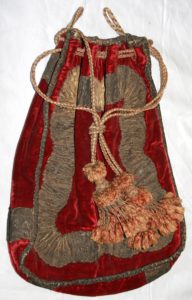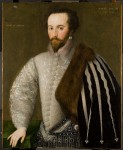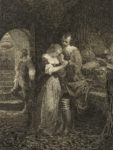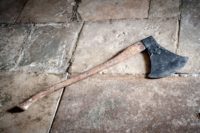 A red silk velvet bag found in the attic of West Horsley Place in Surrey may have been used to carry an illustriously gory cargo: the embalmed head of Sir Walter Raleigh. It’s a long shot. There is no organic residue visible to the naked eye that suggests the bag was used to hold the decapitated head of a man executed for treason and the soft, elegant bag is not the type that would have been used to place the head immediately after the execution.
A red silk velvet bag found in the attic of West Horsley Place in Surrey may have been used to carry an illustriously gory cargo: the embalmed head of Sir Walter Raleigh. It’s a long shot. There is no organic residue visible to the naked eye that suggests the bag was used to hold the decapitated head of a man executed for treason and the soft, elegant bag is not the type that would have been used to place the head immediately after the execution.
Raleigh’s head had an extensive history continuing long after it was separated from his neck. Sir Walter was arrested in July 1603, less than four months after the death of Queen Elizabeth, for conspiring to overthrow King James I. At his trial that November, Raleigh denied vociferously having plotted against the king. The only evidence was the written confession of his alleged co-conspirator who was not allowed to testify and be cross-examined at trial.
 Nonetheless, Raleigh was convicted. His death sentence was commuted by King James and he remained imprisoned in the Tower of London until 1617 when the king pardoned him so he could go on yet another epic voyage of discovery, this time seeking out the mythical city of El Dorado in Venezuela. James had ended two decades of war with Spain when he signed the Treaty of London with King Philip III in 1604, so part of the deal with the pardon was that Raleigh wouldn’t resume his old pirating ways and interfere with Spanish colonies or shipping.
Nonetheless, Raleigh was convicted. His death sentence was commuted by King James and he remained imprisoned in the Tower of London until 1617 when the king pardoned him so he could go on yet another epic voyage of discovery, this time seeking out the mythical city of El Dorado in Venezuela. James had ended two decades of war with Spain when he signed the Treaty of London with King Philip III in 1604, so part of the deal with the pardon was that Raleigh wouldn’t resume his old pirating ways and interfere with Spanish colonies or shipping.
When Raleigh’s men disregarded that stricture and raided the settlement of Santo Tomé de Guayana, Raleigh lost his son Walter and sealed his own fate. Upon his return to England in June 1618, he was arrested for the 1603 treason conviction, his pardon now invalidated by the violence against the Spanish colony. He was in poor health and was escorted to London very slowly. A couple of months and a couple of failed escape attempts later, Sir Walter Raleigh was back in the Tower of London where he would spend his last days.
 The Royal Warrant for the execution dated October 28th, 1618, specified Raleigh would not be drawn, hanged and quartered, the usual execution method for traitors, but rather the king’s “pleasure is to have the head only of the said Sir Walter Raleigh cut off at or within our palace of Westminster.” The king’s pleasure would not have to wait long, likely driven by his desire to clear the diplomatic slate of the Raleigh imbroglio so he could get back to the business of arranging his son’s marriage to the Spanish Infanta. The next morning, October 29th, 1618, Raleigh was taken to the Old Palace Yard at Westminster Palace where he was beheaded.
The Royal Warrant for the execution dated October 28th, 1618, specified Raleigh would not be drawn, hanged and quartered, the usual execution method for traitors, but rather the king’s “pleasure is to have the head only of the said Sir Walter Raleigh cut off at or within our palace of Westminster.” The king’s pleasure would not have to wait long, likely driven by his desire to clear the diplomatic slate of the Raleigh imbroglio so he could get back to the business of arranging his son’s marriage to the Spanish Infanta. The next morning, October 29th, 1618, Raleigh was taken to the Old Palace Yard at Westminster Palace where he was beheaded.
The body was buried in St. Margaret’s Church, Westminster, out of sheer expediency. It was the closest to the palace, and this whole business was done in haste in the hopes of avoiding angry crowds. Raleigh was a national hero; popular sentiment was very much on his side. Shipping his headless body to Beddington where Raleigh and his wife had planned to be buried together would have run the risk of drawing far too much attention.
According to the earliest known published account of the execution, Sir Walter’s head “was shewed on each side of the Scaffold, and then put into a red leather bag and his wrought velvet gowne throwne over it, which was afterwards conveyed away in a mourning coach of his Ladyes.” Lady Raleigh had the head embalmed and kept it with her for the remaining 29 years of her life. One source, 18th century antiquarian William Oldys, reported that she preserved the head “in a case.”
Carew Raleigh, the only son of Sir Walter to survive his father, inherited West Horsley Place upon the death of his maternal uncle Sir Nicholas Carew in 1643. He lived there with his mother until her death in 1647. Sir Walter Raleigh’s head lived with them too. After Bess’ death, the head passed to Carew. He told Elias Ashmole (the man the Oxford University’s Ashmolean Museum is named after) that he still had his father’s skull in the 1660s.
Carew sold West Horsley Place to Sir E Nicholas in 1665 and moved to London where he died the next year. He was buried with his father’s body at St. Margaret’s Church, but it was his two eldest sons Walter and Carew who would go to their eternal rest with Sir Walter Raleigh’s head at St Mary’s Church in West Horsley.
 Beheadings are something of a recurring motif in the history of West Horsley Place. Nobody that we know of was actually executed there, but several of its owners have met the slicing side of the headsman’s axe and last year conservators assessing the condition of the building discovered an actual executioner’s axe.
Beheadings are something of a recurring motif in the history of West Horsley Place. Nobody that we know of was actually executed there, but several of its owners have met the slicing side of the headsman’s axe and last year conservators assessing the condition of the building discovered an actual executioner’s axe.